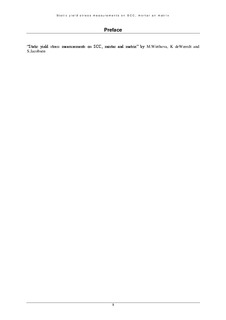Static yield stress measurements on SCC, mortar and matrix
Research report
Permanent lenke
http://hdl.handle.net/11250/2393141Utgivelsesdato
2013Metadata
Vis full innførselSamlinger
Originalversjon
72 p. NTNU, Dept of Structural Engineering, 2013Sammendrag
The static yield stress of fresh self-compacting concrete and its time dependency was measured in different materials and conditions/methods. First the BML ConTech4 was used at very slow rotation by analysis of the data logged in National Instruments lab View giving time dependent static yield stress in 5 different self-compacting mortars. The test cycle involved both static yield measurements starting from unconfined state as well as measurements in a confined state due to a residual stress after stop of the slow rotation. The confined yield stress increases with the same rate of change as the unconfined, though with an upwards parallel displacement due to the increased static yield stress under confined conditions. However, after removal of load and then applying new confinement the linear trend of increase of yield stress as function of time were independent of release/confinement repetition and the two lines (unconfined and confined) were parallel. We also observed linear increase of static shear moduli with time. Finally we investigated the static yield stress of the filler modified paste portion of the mortar in a Physica Paar parallel plate rheometer. First we observe the usual improved sensitivity of the static yield at very low increase of strain rate from zero, giving exponential increase of time dependant stress (gel strength test) compared to static yield in the constant strain rate test. A very clear linear time dependant increase of shear modulus with time was found, though with much lower absolute values than in mortar.
The rate of change of static yield stress of SCC and mortar varied in the range 0.014 – 0.25 Pa/s in unconfined tests during the first 2,5 hours. In confined tests it is 0.2 – 0.41 P/s. The only values at t = 0 are by linear regression and extrapolation, often giving values less than zero indicating some kind of non-linearity at early age although the increase after app 30 minutes seems linear both for unconfined an confined tests. The test principles in the four tests were: coaxial viscometer for mortar, static plate with continuous development, inclined plane and parallel plate for paste or matrix. The differences between the measurements, briefly, concern both the type of materials that can be used (SCC vs matrix) and the test principles and stress conditions during testing. Our materials were mortar with w/b ≈ 0.50, 40 volume % matrix and 8 mm maximum aggregate size, as well as matrix with similar composition as in the mortar. Apparently, static yield is very sensitive to both test method and how it is calculated. Based on this limited experience it is hard to give a definite answer but the confinement in the ConTech viscometer is possibly a good thing for simulation of concrete confined in a narrow tall wall. This is the geometry where yield stress build-up is of interest for formwork pressure. The inclined plane showed some weaknesses with larger aggregate particles loosening from the surface but might relate to aggregate segregation. The plate test also has its weaknesses with small roughness on the surface and should perhaps have been exchanged for geometry with vanes of some kind normal to the plate to get similar “grip” as the vanes of the viscometer. More work is needed to obtain a test. Possibly different tests are needed for yield stress for different purposes: related to formwork pressure, to casting joints and to stability of aggregate particle sinking. Observations of difficulties in static yield stress measurements and discussion of the magnitudes of these variations in various types of measurements will hopefully lead to more knowledge in this field.
